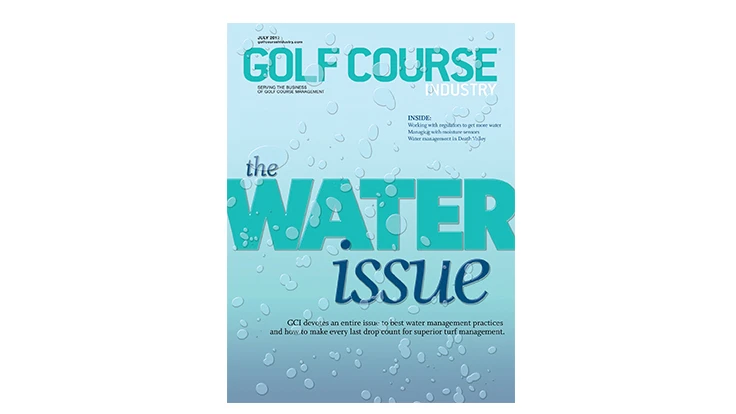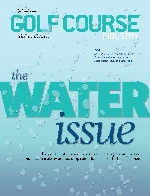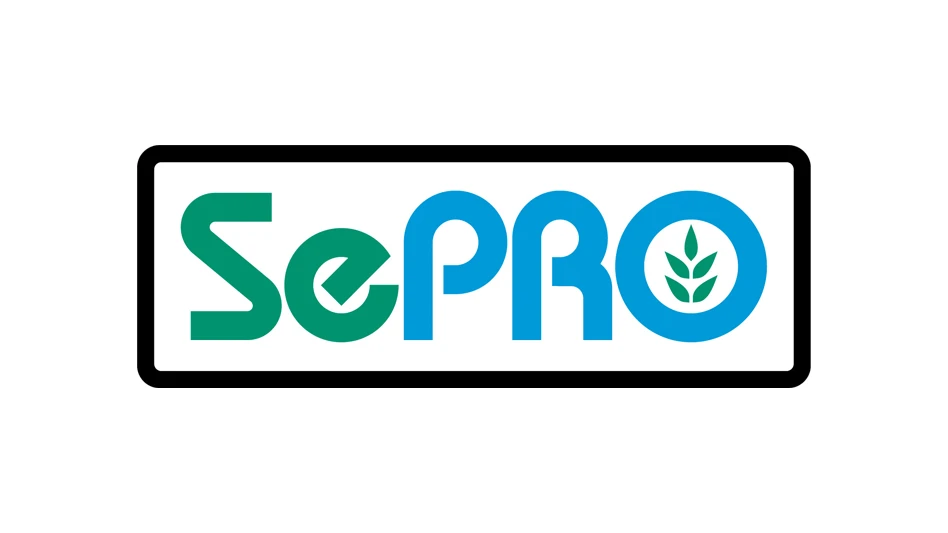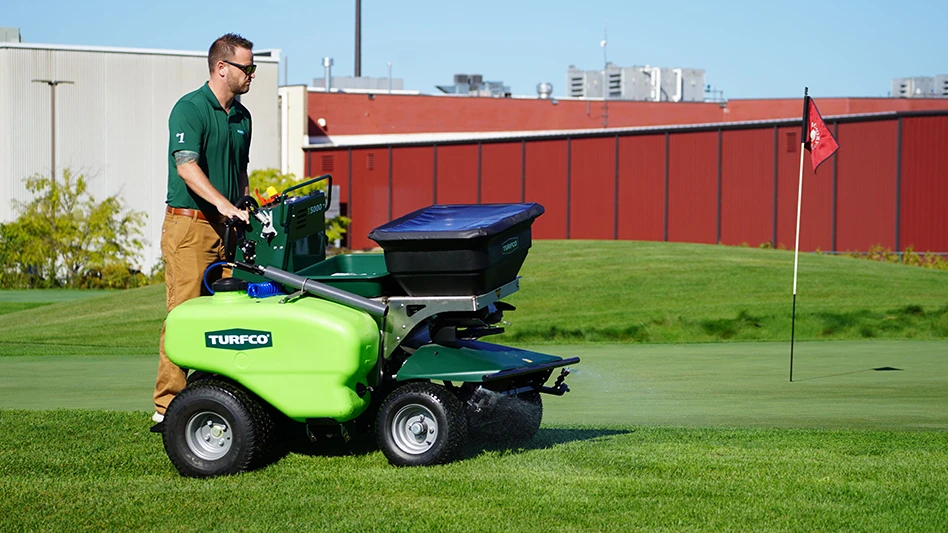
 Cloninger: “Water is an area where I can reduce cost and improve conditions at the same time.” Cloninger: “Water is an area where I can reduce cost and improve conditions at the same time.” |
Tim Cloninger has been the superintendent at Shadow Creek since July of 2011. He was also the assistant superintendent from late 2005 to the end of 2007. Tim has an interesting background for a golf course superintendent, which includes positions in Australia, Mexico and the Cayman Islands. In addition to obtaining a turf degree, he has done graduate work in Water Policy and Geographical Information Systems (GIS). Given his background working with water policy and state of the art technologies, I interviewed Tim about maintaining an exclusive golf course in the Las Vegas heat with a limited water supply.
How old is the irrigation system at Shadow Creek, and what type of system is it? The irrigation system at Shadow Creek was originally installed with the construction of the golf course in 1990. The fairways and rough irrigation systems were redone in 2003 and the greens and tees in 2004. In 2008 the golf course was renovated and adjustments were made to the irrigation system. The native area irrigation systems are all still original. A new 7,200-gallon-per minute (gpm) Watertronics pump station was installed in 2011. The system is primarily Rain Bird with some miscellaneous equipment in the native areas.
What don’t you like about your irrigation system? The native areas – which are native for the golf course, but not native to Las Vegas – are all block controlled and waste a lot of water. They need major improvements as there is not enough control and they have poor sprinkler spacing as well as aging equipment. There is also a large amount of drip irrigation installed and I do not have a good handle on how much water it is using and I feel if we can improve the scheduling of the drip irrigation we can save a lot of water.
Is there anything you like about your irrigation system? There are a lot of quick couplers on the course and they are spaced in such a way that we can water any turf area on the golf course with a 100-foot hose, which we do a lot. I also like that we have two-part circle sprinklers on the edge of the fairways to separate the rough and fairway watering which is nice if you don’t over seed, but also because our fairways are sand capped and the rough isn’t so they have very different watering requirements.
How does your irrigation system waste water? The block system in the native areas is wasteful on many levels. The spacing is not ideal and the system is old. The zones cover a lot of area with different soils and different plant material as well as widely varying topography. There is a very large amount of drip irrigation installed on the perimeter of the property and the plantings along the golf course. We do not have a very good handle on the size of the drip zones and I think could do a better job of scheduling the drip zones. We also have a large amount of surface water with a high evaporation rate.
If money was no object, what would your No. 1 irrigation improvement be? I would work on the native areas which in Las Vegas are not native with only 4 inches of rainfall a year they are irrigation dependent. I would fix the spacing’s and get more control of the operation by having single sprinkler control or much smaller zones. Given our plant height, many of the sprinklers need to be above grade to provide more uniform coverage.
Water policy is starting to influence golf course watering and will continue to in the future. How does your educational background in water policy help you as a golf course superintendent? It helps to have knowledge of the water situation in the region and in the country. It gives you a better understanding of where golf courses fit in the realm of water use and understanding the need for water conservation. Having an understanding of local/regional water policy when talking to policy makers can be used to represent golf courses in a better way. If gives me the ability to communicate with regulators before policy is made, not after. If you show concern that you are trying to do the right thing you end up with better policy in the long run. I provide facts that compare golf with other water use sectors.
When I worked at the University of Arizona Water Resources Research Center I noticed that there is a lot of misinformation about golf course water use. It is important to have someone from golf who understands water use and water policy and is not just representing one side.
Describe your water supply. We have a 4-acre irrigation storage pond between holes No. 3 and No. 4. The water supply is made up of approximately half permitted groundwater from three wells and half from a 10-inch potable city water feed. Two of the wells discharge directly into the pond and the city water and the newest well into the pump house wet well. Since the irrigation pond is very much in play, the level needs to be carefully managed. The wells also have to be managed to make sure their individual permit amounts are not exceeded on a monthly and yearly basis. Golf courses in Las Vegas use large amounts of water (annual ET rates are 90 inches) and the supply needs to be carefully managed. Shadow Creek is no exception.
How do you determine the amount of water to apply? The green, tees and approaches are sand based bent grass and I use a TDR 3000 soil moisture meter daily to gauge the amount of water to apply. We have calculated very specific precipitation rates for each area and water deeply and infrequently to a specified depth and not based on time. There is also a small sample (four greens) of in ground sensors that report the soil moisture and salinity. The in ground sensors assist me with determining when to flush the greens. I lean to the dry side and try to stay consistent throughout the week and usually hit watering hard on Fridays.
 The fairways, rough and native areas run off of the reference ET produced by our two on-site weather stations. Each zone is assigned to one of the weather stations. The turf ET is then calculated based off of the crop coefficient for the type of turf. Our crop coefficient changes throughout the year as our turf type changes from ryegrass to Bermuda grass during over seeding. We start with an 80 percent crop coefficient and do a global adjust based on what the course is doing. Because our summer water window is not very flexible we can’t move around our schedule too much, but do during the rest of the year. We don’t throw water out just to water based on ET. Every day is a game-time decision as to what to water and how much.
The fairways, rough and native areas run off of the reference ET produced by our two on-site weather stations. Each zone is assigned to one of the weather stations. The turf ET is then calculated based off of the crop coefficient for the type of turf. Our crop coefficient changes throughout the year as our turf type changes from ryegrass to Bermuda grass during over seeding. We start with an 80 percent crop coefficient and do a global adjust based on what the course is doing. Because our summer water window is not very flexible we can’t move around our schedule too much, but do during the rest of the year. We don’t throw water out just to water based on ET. Every day is a game-time decision as to what to water and how much.
Do you pay for water? Yes. Water costs account for a large part of the annual budget and the cost of water is only going to continue to increase in Las Vegas and most other areas. The electricity to pump that water is also expensive and is significant, but not as large a part of the budget.
In addition to Water Policy you also have a GIS background. What is GIS and how to you utilize it in your irrigation practices? Geographical Information Sciences is the background and Geographical Information Systems is the practical use of the science. I am in the process of using a soil moisture meter to create soil moisture profile distribution uniformity maps on a GIS platform. I am concentrating on fairways and rough because they are the larger water users and larger areas. Mapping something as small as a green requires a very fine scale and very good equipment. There is too much hand watering and very subtle differences in the topography of greens, so the data is too inconsistent. Fairways and roughs are more normalized and it is easier to see trends.
I will use these maps to adjust stations and reduce runtimes. I map hot spots also. I am also mapping irrigation components and trouble areas and creating plans to fix the trouble spots. This will include adjusting sprinkler heads, maybe amending the soils and changing nozzles.
By mapping all the dead spots late last summer, I was able to sod those areas earlier this year to give the Bermuda a chance to grow all summer. It also provides a data and a record for historical perspective. I will also map the electrical conductivity and generate soil type maps and use those to create management zones. For each of the management zones I hope to develop specific irrigation and fertility schedules. I am expecting very good results from the GIS efforts I am undertaking.
At Shadow Creek, the soils are very different due to so much earth moving. The site was originally flat and now has some 80 feet of elevation change. That along with the remodel has resulted in a very diverse soil profile depending where you are on the golf course.
From a superintendent’s perspective, what is the easiest way to save water? What is the hardest? The easiest way is to promote most drought tolerant turf grasses. You need to be diligent on your scheduling and use weather and all other information available to make the irrigation system as efficient as possible. You need to have buy-in from your staff to do a lot of hand watering. Also, keeping things lean and not watering hot spots with irrigation but by hand watering is essential.
Do you consider yourself an efficient irrigator? How are you efficient? Yes, all measures are taken when scheduling irrigation to ensure the most efficient watering window. In Las Vegas there are frequently strong winds and I mange the water window to avoid irrigation in high winds as nothing gets accomplished from a watering standpoint when it is windy. We try to water when the winds are calm but don’t have that much flexibility in the summer due to water window constraints.
Is your water quality a concern? The water quality at Shadow Creek is excellent when compared to other golf courses in the Las Vegas area. However, the accumulation of sodium is always an issue in a climate that receives only 1 to 4 inches of annual rainfall and the salinity has to be managed.
Are you under pressure to save water? In this economic climate I think every golf course is looking for innovative ways to save money while producing a quality product and Shadow Creek is no exception. Water is an area where I can reduce cost and improve conditions at the same time. Also management would like to see additional water savings due to the economics. One way to do that is to eliminate or reduce the amount of area we over seed which could save up to 20 percent, but it is a tough sell.
Have you been able to decrease water use at Shadow Creek, if so how? So far I have reduced water use by 15 percent. The majority of the water reduction has been accomplished by changing the crop coefficients on a monthly basis. Rather than keeping the crop ET at a constant, it changes based on the variety of turf that is growing (ryegrass or Bermuda) and where.
An increase in hand watering has also saved significant amounts of water while producing a more uniform turf. I have stressed the importance of hand watering to our section workers and have allotted them more time to hand water.
Brian Vinchesi writes GCI’s irrigation column.

Explore the July 2012 Issue
Check out more from this issue and find your next story to read.
Latest from Golf Course Industry
- Atlanta Athletic Club approves funding for master plan
- Maximizing Cultural Practices and Agronomic Benefits with Minimal Surface Disruption
- Real Answers about Spray Nozzle Choices
- From the Course to the Factory: How Customer Insights Drive Innovation
- New & Proven Enzyme Strategies for Sprayable Thatch Management
- Innovating Tomorrow: Wittek’s New Products & Industry Staples
- PBI-Gordon introduces new field development team
- The Cabot Collection announces move into course management






